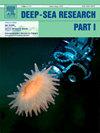从特定化合物稳定同位素和微生物群落分析推断的北太平洋深海平原表层颗粒有机质向深海平原的转化
IF 2.1
3区 地球科学
Q2 OCEANOGRAPHY
Deep-Sea Research Part I-Oceanographic Research Papers
Pub Date : 2025-09-23
DOI:10.1016/j.dsr.2025.104597
引用次数: 0
摘要
在地表水中产生的颗粒有机物质(POM)在下沉到深海海底并作为底栖生物和远洋食物网的基础时,经过微生物和后生动物群落的广泛改造和分解。在这里,我们研究了贫营养北太平洋副热带环流(ALOHA站)和富营养加利福尼亚洋流系统(M站)中不同大小类别的POM如何在整个水柱中经历微生物改变。化合物特异性稳定同位素分析表明,采样方法对定量输出到深海的POM类型有强烈影响。系泊的深海沉积物捕集器捕获的物质与表面POM的同位素组成相匹配,表明它们收集了大而快速下沉的颗粒,与在相同深度通过原位过滤收集的更重加工的颗粒形成对比。我们首次将氨基酸的δ15N分析扩展到深海和深海,证实了大多数颗粒再矿化和再加工发生在水柱的上部~ 400 m,而不管初始表面生产力如何。在ALOHA站点,我们进一步使用16S rRNA条形码来表征与POM相关的微生物群落。研究发现,在ALOHA站的上层水柱中存在丰富的化化岩自养氨氧化古菌,氨基酸同位素分析表明,它们的丰度与高异养重工区相对应。本文章由计算机程序翻译,如有差异,请以英文原文为准。
Transformations of particulate organic matter from the surface to the abyssal plain in the North Pacific as inferred from compound-specific stable isotope and microbial community analyses
Particulate organic matter (POM) produced in surface waters undergoes extensive reworking and breakdown by microbial and metazoan communities as it sinks to the abyssal seafloor and serves as the base of benthic and pelagic food webs. Here, we examined how various size classes of POM in the oligotrophic North Pacific Subtropical Gyre (Station ALOHA) and in the eutrophic California Current System (Station M) undergo microbial alteration throughout the water column. Compound-specific stable isotope analysis showed that sampling method strongly impacts the type of POM quantified as export to the deep sea. Moored abyssal sediment traps captured material that matched the isotopic composition of surface POM, indicating they collected large, fast-sinking particles, in contrast to the more heavily reworked particles collected with in situ filtration at the same depths. Extending δ15N analyses of amino acids to bathypelagic and abyssopelagic depths for the first time, we confirmed that most particle remineralization and reworking occurs within the upper ∼400 m of the water column regardless of initial surface productivity. At Station ALOHA, we further used 16S rRNA barcoding to characterize the microbial communities associated with the POM. We found that chemolithoautotrophic ammonia-oxidizing archaea are abundant in the upper water column at Station ALOHA and that their abundance corresponded to regions of high heterotrophic reworking as indicated by amino acid isotope analysis.
求助全文
通过发布文献求助,成功后即可免费获取论文全文。
去求助
来源期刊
CiteScore
4.60
自引率
4.20%
发文量
144
审稿时长
18.3 weeks
期刊介绍:
Deep-Sea Research Part I: Oceanographic Research Papers is devoted to the publication of the results of original scientific research, including theoretical work of evident oceanographic applicability; and the solution of instrumental or methodological problems with evidence of successful use. The journal is distinguished by its interdisciplinary nature and its breadth, covering the geological, physical, chemical and biological aspects of the ocean and its boundaries with the sea floor and the atmosphere. In addition to regular "Research Papers" and "Instruments and Methods" papers, briefer communications may be published as "Notes". Supplemental matter, such as extensive data tables or graphs and multimedia content, may be published as electronic appendices.

 求助内容:
求助内容: 应助结果提醒方式:
应助结果提醒方式:


